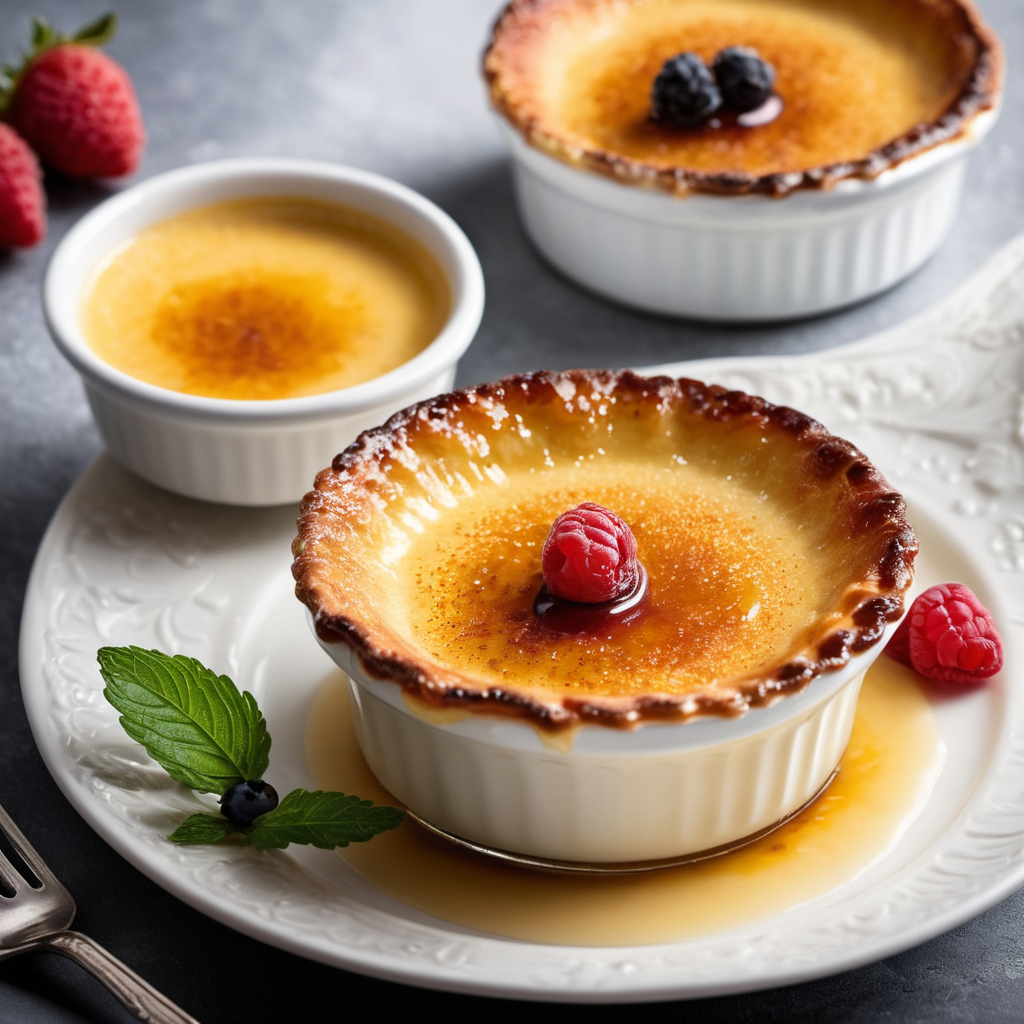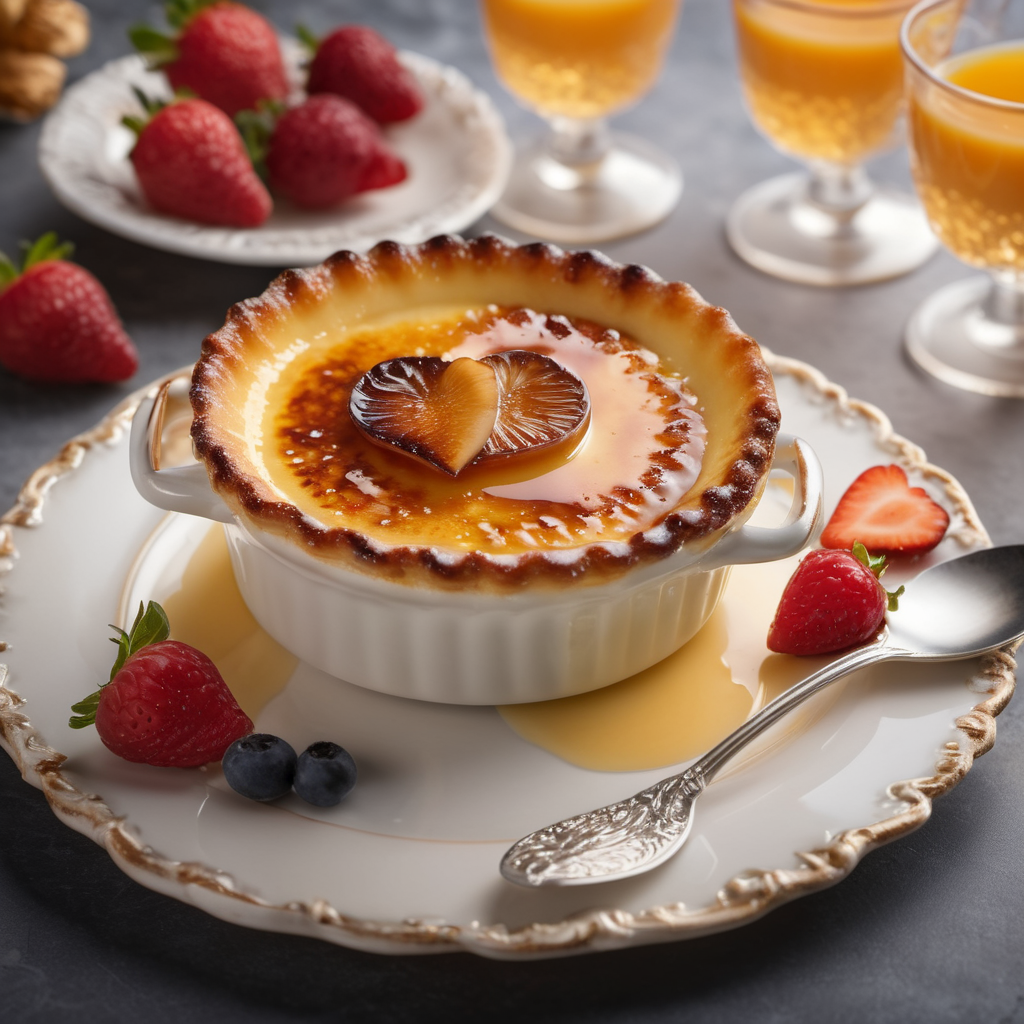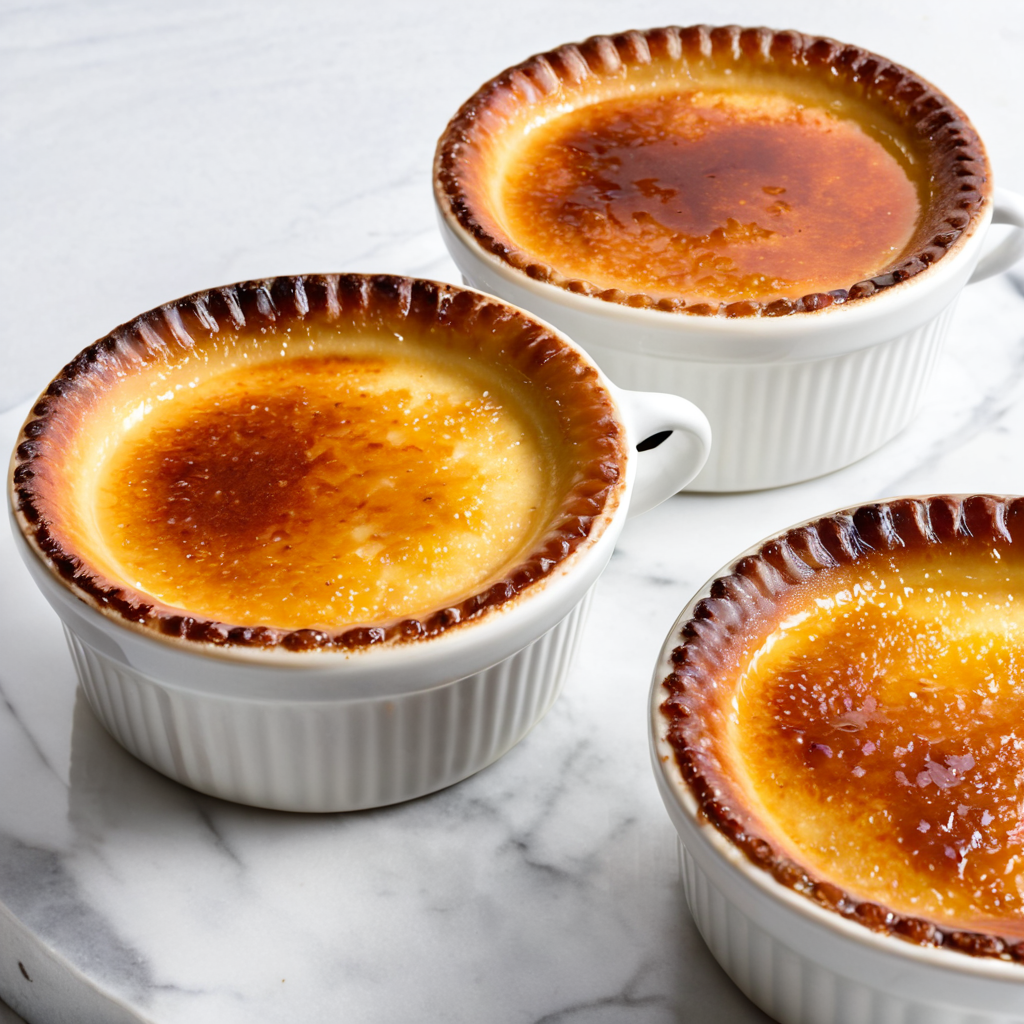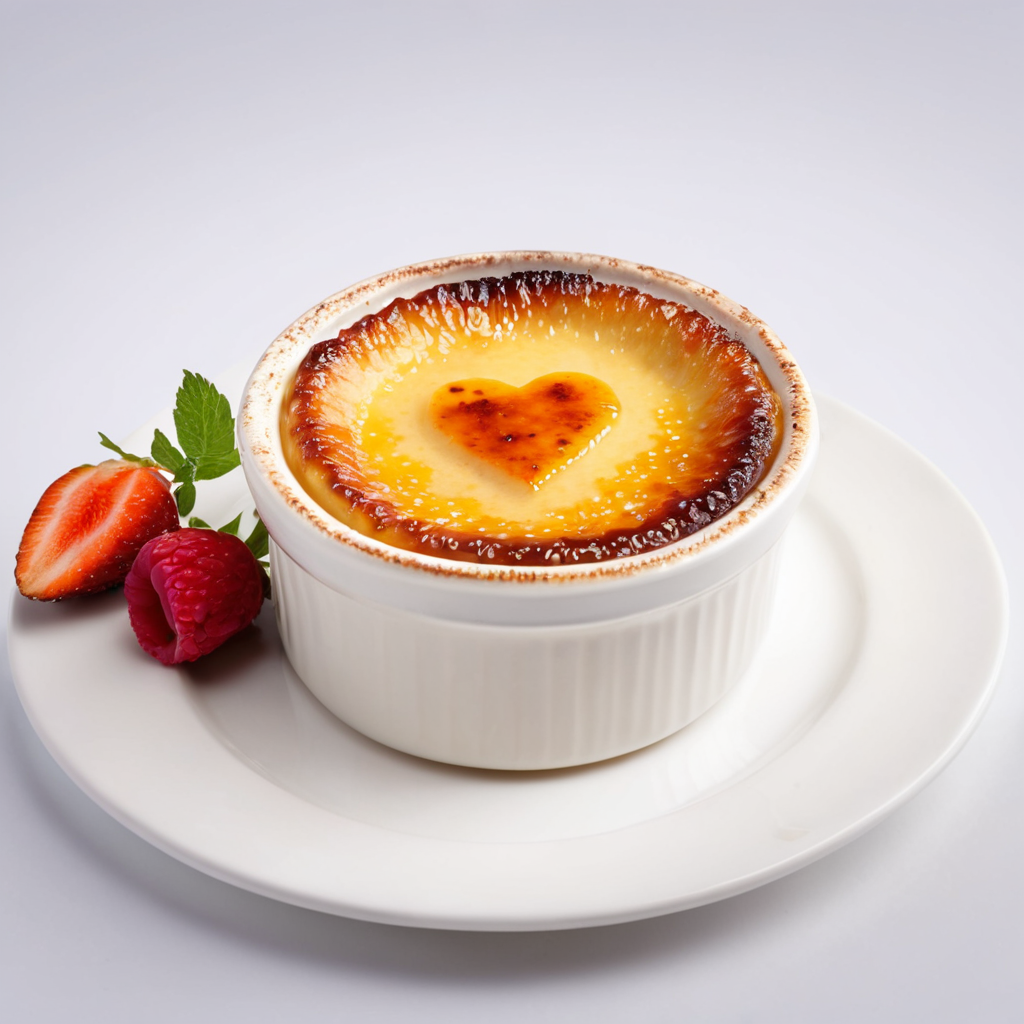Introduction
Classic crème brûlée, a dessert that epitomizes elegance and indulgence, is loved for its luxuriously creamy custard base and perfectly caramelized sugar topping. This timeless French treat has graced dinner tables and fine dining menus for centuries. Despite its sophisticated appearance, classic crème brûlée Recipe is surprisingly simple to prepare at home.
Whether you’re hosting a dinner party or treating yourself, mastering this dessert will leave your guests impressed and your taste buds delighted. This guide will walk you through the Classic Crème Brûlée Recipe, complete with tips for achieving a silky texture, the signature crackling sugar crust, and creative variations. Let’s dive into the art of making this iconic dessert that never fails to steal the show!
What Is Classic Crème Brûlée?
Classic crème brûlée, often translated as “burnt cream” in French, is a sophisticated dessert that combines a velvety custard base with a crackling layer of caramelized sugar on top. The contrast between the creamy texture and the crisp topping makes it a sensory delight, appealing to both taste and texture.
This iconic dessert is made with just a handful of simple ingredients: cream, egg yolks, sugar, and vanilla. Despite its simplicity, the techniques required to achieve the perfect custard and caramelized topping give classic crème brûlée its reputation as a luxurious treat. Traditionally served in small ramekins, it is a dish that speaks of elegance and indulgence, making it a staple in fine dining and special occasions.
Origin and History of Classic Crème Brûlée
The roots of classic crème brûlée can be traced back to France, where it is considered a culinary treasure. The earliest documented recipe appeared in François Massialot’s 1691 cookbook, Le Cuisinier Royal et Bourgeois, where the dessert was already described in a form very similar to what we know today.
However, crème brûlée’s history is not exclusively French. Similar desserts existed in Spain, known as crema catalana, and in England as burnt cream or Trinity cream, famously served at Trinity College in Cambridge. Despite these variations, the French version gained prominence due to its refinement and association with haute cuisine. Today, classic crème brûlée is a beloved dessert worldwide, celebrated for its rich flavors and timeless appeal.
Why Classic Crème Brûlée Is a Dinner Party Favorite
Crème brûlée has earned its place as a dinner party staple for several reasons:
- Classic crème brûlée has earned its place as a dinner party staple for several reasons:
- Elegance: The visual appeal of the golden caramelized sugar topping and the refined presentation in ramekins make it a sophisticated choice for any occasion.
- Taste: Its combination of rich, creamy custard and a crunchy, caramelized topping offers a luxurious and satisfying flavor experience.
- Simplicity: While it looks impressive, classic crème brûlée is surprisingly easy to prepare ahead of time. You can make the custard in advance and caramelize the sugar just before serving, minimizing last-minute stress.
- Universal Appeal: This dessert caters to a wide range of palates, making it a safe yet memorable choice for diverse guest lists.
Key Features of a Perfect Classic Crème Brûlée
To create a flawless classic crème brûlée, it’s essential to master its key features:
- Smooth Custard: The custard should have a creamy, silky texture, achieved by carefully tempering the eggs and baking the dessert in a water bath to prevent curdling or overcooking.
- Caramelized Sugar Top: The signature crackling top is created by sprinkling sugar evenly over the custard and torching it until it forms a golden-brown crust. The sugar should melt uniformly without burning, creating a satisfying “crack” when tapped with a spoon.
- Balance of Sweetness: A perfect classic crème brûlée is sweet but not cloying. The richness of the custard is complemented by the slight bitterness of the caramelized sugar, creating a harmonious flavor profile.
- Aromatic Touches: While vanilla is the traditional flavoring, some variations include hints of citrus zest, coffee, or liqueurs like Grand Marnier to add a unique twist.
Understanding these features ensures that your classic crème brûlée not only tastes incredible but also captures the magic of this classic dessert.

Essential Ingredients for the Classic Crème Brûlée Recipe
Creating a perfect classic crème brûlée starts with selecting high-quality ingredients and using the right tools. With just a few basic components, this dessert showcases how simplicity can lead to extraordinary results when each element is carefully chosen and handled.
Essential Ingredients
The beauty of classic crème brûlée lies in its simplicity, relying on a short list of ingredients that each play a critical role:
- Egg Yolks: These are the foundation of the custard, providing richness and a silky texture. Use fresh, high-quality egg yolks for the best flavor and consistency.
- Heavy Cream: The cream is what gives classic crème brûlée its luxurious creaminess. Opt for heavy cream with a high fat content to ensure the custard sets properly and has a rich mouthfeel.
- Sugar: Sugar serves two purposes: sweetening the custard and forming the signature caramelized topping. For the topping, granulated sugar is preferred as it melts evenly under the torch.
- Vanilla: Vanilla adds a warm, aromatic depth to the custard. Whether using vanilla extract, vanilla paste, or a real vanilla bean, it’s an essential ingredient that defines the flavor of the dessert.
Choosing the Best Vanilla for Your Classic Crème Brûlée Recipe
Vanilla is the soul of a classic crème brûlée, so it’s important to choose the best form of vanilla to elevate its flavor:
- Real Vanilla Beans: For the most intense and authentic flavor, scrape the seeds from a vanilla bean pod. The tiny black specks dispersed throughout the custard not only look elegant but also infuse it with a pure, robust vanilla aroma.
- Vanilla Extract: High-quality pure vanilla extract is a convenient and effective option, delivering excellent flavor without the need for a vanilla pod. Avoid imitation extracts, as they lack the depth and complexity of real vanilla.
- Vanilla Paste: A middle ground between beans and extract, vanilla paste contains concentrated vanilla along with flecks of seeds, offering both flavor and visual appeal.
Each choice has its merits, and your selection may depend on availability, budget, and the level of indulgence you’re aiming for.
The Best Equipment for a Perfect Classic Crème Brûlée
The right tools are essential for achieving professional-level results with your classic crème brûlée:
- Ramekins: These small, oven-safe dishes are the traditional choice for classic crème brûlée. Their size helps the custard cook evenly and provides the perfect portion for individual servings. Choose ramekins with a flat, wide surface to maximize the caramelized topping.
- Kitchen Torch: A kitchen torch is key for caramelizing the sugar topping to a golden, crackling perfection. It provides precise control, allowing you to melt the sugar evenly without overheating the custard beneath.
- Baking Tray and Water Bath: The custards are baked in a water bath (bain-marie) to ensure even heat distribution and prevent curdling. A sturdy baking tray that can hold the ramekins and enough hot water is essential for this step.
- Whisk and Mixing Bowls: For blending the custard ingredients smoothly without over-incorporating air, which could create bubbles that disrupt the texture.
- Fine-Mesh Sieve: Straining the custard mixture before pouring it into the ramekins removes any lumps or egg solids, ensuring a silky final texture.
By using these essential ingredients and tools, you’re setting the stage for a flawless classic crème brûlée that impresses with both taste and presentation.
Step-by-Step Instructions for a Classic Crème Brûlée Recipe
Making crème brûlée at home can feel like a professional-level accomplishment, but with the right steps, it’s surprisingly achievable. Follow this detailed guide to create a dessert that’s silky, creamy, and topped with a perfectly caramelized sugar crust.
Preparing the Custard
The custard is the heart of crème brûlée, and careful preparation ensures a smooth and creamy texture without curdling. Here’s how to do it:
- Heat the Cream: Gently warm the heavy cream in a saucepan over medium heat until it’s hot but not boiling. Heating the cream helps it incorporate more easily with the egg yolks and infuses any added flavors, like vanilla.
- Infuse the Vanilla: If using a vanilla bean, split it lengthwise, scrape out the seeds, and add both seeds and pod to the cream. Let it steep while the cream heats, then remove the pod before mixing. For extract or paste, stir it in after the cream is warmed.
- Mix the Egg Yolks and Sugar: In a separate bowl, whisk the egg yolks and granulated sugar together until the mixture is pale and slightly thickened. This step helps the sugar dissolve and prevents a grainy texture.
- Temper the Eggs: To prevent curdling, slowly pour a small amount of the warm cream into the egg mixture while whisking constantly. Gradually add the rest of the cream, continuing to whisk. This technique brings the eggs up to temperature without cooking them.
- Strain the Custard: Pass the mixture through a fine-mesh sieve to remove any solids or foam, ensuring a silky custard.
Baking the Crème Brûlée
Baking the custard in a water bath (bain-marie) is essential for even cooking and achieving the characteristic creamy texture:
- Prepare the Ramekins: Arrange the ramekins in a deep baking tray or roasting pan.
- Pour the Custard: Divide the custard evenly among the ramekins, filling them about three-quarters full.
- Create the Water Bath: Carefully pour hot water into the baking tray, filling it until the water level reaches halfway up the sides of the ramekins. The water bath prevents the custard from overheating and curdling by providing gentle, even heat.
- Bake: Preheat the oven to 325°F (160°C) and bake the custards for 30-40 minutes, or until the edges are set but the centers still have a slight jiggle. Avoid overbaking, as this can lead to a rubbery texture.
- Cool and Chill: Remove the ramekins from the water bath and let them cool to room temperature. Cover each ramekin with plastic wrap and refrigerate for at least 4 hours, or overnight, to set the custard fully.
Caramelizing the Sugar Topping
The signature caramelized sugar crust is what sets crème brûlée apart, offering a delightful contrast to the creamy custard below. Here’s how to achieve that perfect crackle:
- Add the Sugar: Sprinkle an even layer of granulated sugar over the chilled custards. Use about 1-2 teaspoons per ramekin, depending on the size. Tilt and rotate the ramekin to ensure the sugar coats the surface uniformly.
- Torch Method: Using a kitchen torch, melt the sugar by holding the flame about 2-3 inches above the surface. Move the torch in circular motions to evenly heat the sugar, letting it bubble and caramelize into a golden crust. Be careful not to burn the sugar.
- Oven Broiler Method: If you don’t have a torch, place the ramekins on a baking sheet and position them under the broiler. Keep a close eye, as the sugar can burn quickly. Rotate the tray as needed to ensure even caramelization.
- Cool Slightly: Allow the caramelized topping to cool for a minute or two, forming a hard shell that cracks under the pressure of a spoon.
By following these detailed steps, you’ll create a crème brûlée that’s as stunning as it is delicious—perfectly creamy, delicately flavored, and topped with a caramel crust that offers just the right amount of crunch.

Top Tips for Perfecting Your Crème Brûlée Recipe
Creating the perfect crème brûlée can feel like an art form, but with these expert tips and tricks, you can master this classic dessert and impress your guests every time.
Avoiding Common Mistakes
Even with simple ingredients, crème brûlée can go awry. Here’s how to avoid the most common pitfalls:
- Preventing Overcooking: Overcooked custard becomes rubbery and loses its creamy texture. To avoid this, check for doneness by gently jiggling the ramekin—if the edges are set but the center still wobbles slightly, it’s ready. Also, ensure your oven temperature is accurate; investing in an oven thermometer can make a big difference.
- Avoiding a Grainy Texture: Graininess occurs when the eggs curdle, often due to high heat. Temper the egg mixture carefully and bake in a water bath to maintain a gentle, even cooking environment.
- Perfecting the Sugar Topping: Burnt sugar can ruin the dessert’s delicate balance. If using a kitchen torch, move it steadily and avoid holding the flame too close for too long. For broiling, keep the ramekins at a safe distance from the heat source and watch them closely.
Presentation Tips to Impress Guests
Crème brûlée is already an elegant dessert, but thoughtful presentation can elevate it even further:
- Garnishing with Fruits: Fresh berries, such as raspberries, blueberries, or sliced strawberries, add a pop of color and a refreshing contrast to the rich custard. Arrange them artfully around the edge or pile them in the center.
- Edible Flowers: Small edible flowers, like violets, pansies, or lavender sprigs, can give a sophisticated touch. Be sure they are food-safe and unsprayed.
- Chocolate Decorations: Drizzle melted chocolate over the caramelized sugar or add chocolate shavings for a decadent twist. Dark chocolate works especially well, balancing the sweetness of the custard.
- Serve in Stylish Ramekins: Choose ramekins with unique designs or colors to match your table setting. For a rustic charm, consider using small mason jars.
Customizing Your Crème Brûlée
One of the joys of crème brûlée is its versatility. Here are some ways to infuse unique flavors and make the recipe your own:
- Coffee: Add a teaspoon of instant espresso powder to the warm cream for a rich, aromatic coffee flavor. Pair with a dark chocolate garnish for a mocha-inspired twist.
- Citrus: Incorporate lemon, orange, or lime zest into the custard base for a bright, zesty flavor. Blood orange zest can add a hint of exotic flair.
- Spices: Warm spices like cinnamon, nutmeg, or cardamom can create a cozy, aromatic dessert perfect for the holidays. Add a pinch to the cream while heating it.
- Liqueurs: Enhance the custard with a splash of liqueur, such as Grand Marnier for a citrusy kick, amaretto for an almond undertone, or Baileys for a creamy richness.
- Exotic Twists: Try infusing the cream with unique flavors like matcha, lavender, or chai tea. These additions can give the dessert a contemporary, global touch.
By following these tips and embracing your creativity, you’ll consistently produce a crème brûlée that’s not only delicious but also memorable. Whether you stick to the classic recipe or experiment with new flavors, each ramekin will be a show-stopping masterpiece.

Frequently Asked Questions About Classic Crème Brûlée
Crème brûlée is a beloved dessert, but it can spark some common questions for both novice and seasoned cooks. Here, we address some of the most frequently asked questions to ensure your crème brûlée journey is smooth and successful.
Can You Make Classic Crème Brûlée Ahead of Time?
Yes, crème brûlée is an excellent make-ahead dessert, making it perfect for dinner parties and gatherings. Here are some key storage tips:
- Preparing the Custard in Advance: After baking the custard and allowing it to cool, cover each ramekin tightly with plastic wrap or foil to prevent the custard from absorbing odors in the refrigerator. It can be stored this way for up to 2-3 days.
- Caramelizing Just Before Serving: The signature caramelized sugar topping should always be added right before serving. If done too far in advance, the sugar loses its crunch and may become sticky. Once the custard is chilled and ready to serve, sprinkle an even layer of sugar and caramelize it for that perfect crackly top.
- Freezing Crème Brûlée: While not ideal, you can freeze baked custards without the sugar topping for up to a month. Allow them to thaw overnight in the refrigerator and add the sugar topping before serving.
What’s the Best Way to Caramelize Sugar?
The caramelized sugar topping is the hallmark of crème brûlée, and there are two main methods to achieve it:
- Using a Kitchen Torch:
- A kitchen torch offers precision and control, allowing you to caramelize the sugar evenly without affecting the custard beneath.
- Sprinkle an even layer of sugar over the custard, then move the flame in a circular motion, keeping it about 2-3 inches above the surface.
- Focus on one area at a time, avoiding holding the flame too close to prevent scorching.
- Using an Oven Broiler:
- If you don’t have a torch, the broiler is a handy alternative. Preheat the broiler to its highest setting.
- Place the ramekins on a baking tray and set them under the broiler, about 4-6 inches from the heat source.
- Watch closely, as the sugar can go from caramelized to burnt in seconds. Rotate the tray as needed for even browning.
- Choosing the Right Sugar: Granulated sugar works best for a smooth, crackly finish. For added flavor, mix in a small amount of brown sugar, though it may take slightly longer to caramelize.
Is Classic Crème Brûlée Difficult for Beginners?
Crème brûlée is the ultimate indulgence, and making it at home is easier than you think! Learn how to make the perfect Classic Crème Brûlée with this classic recipe from King Arthur Baking. Enjoy a delicious, creamy dessert with a perfectly caramelized sugar top
Crème brûlée may seem intimidating, but it’s surprisingly approachable for beginners when armed with the right tips and techniques. Here’s why you can tackle it with confidence:
- Simple Ingredients: The recipe relies on just a handful of pantry staples—egg yolks, cream, sugar, and vanilla. No need for exotic or hard-to-find ingredients.
- Straightforward Technique: The most crucial step is tempering the eggs, which involves slowly adding warm cream to the yolks while whisking. This prevents curdling and ensures a silky custard. With a little patience, this step is easy to master.
- Reliable Equipment: You don’t need professional-grade tools. Basic kitchen equipment like a whisk, ramekins, and a baking tray with a water bath will suffice. A torch is a helpful bonus but not mandatory.
- Mistakes Are Fixable: Even if your first attempt isn’t perfect, small errors like slightly overcooking the custard or unevenly caramelizing the sugar don’t ruin the dessert. Practice makes perfect!
By following these insights, you can confidently make crème brûlée that wows every time, whether it’s your first try or your fiftieth.
Conclusion
this Classic Crème brûlée recipe is the perfect combination of simplicity and sophistication, making it a dessert that truly stands out at any occasion. This guide has walked you through every step, from understanding its rich history to mastering the art of caramelizing the sugar topping. By following the tips and techniques provided, you can create a dessert that’s as visually stunning as it is delicious.
Whether you’re a seasoned baker or a beginner looking for a foolproof way to impress your guests, this classic crème brûlée recipe is a sure winner. The silky-smooth custard, contrasted by the crisp caramelized sugar topping, is a timeless treat that everyone will love. It’s the kind of dessert that brings smiles and earns compliments—making it well worth the effort.
We’d Love to Hear from You!
Have you tried making Classic Crème Brûlée Recipe using this guide? We’d love to see your results and hear about your experience! Share your thoughts, tips, or photos in the comments section below. Did you experiment with unique flavors or toppings? Let us know how you made this recipe your own!
Explore More Sweet Delights
If you enjoyed this recipe, why not explore some of our other decadent dessert recipes? From chocolate soufflés to fruit tarts, we have plenty of ideas to satisfy your sweet tooth. Be sure to check out our dessert collection for more inspiration.
Spread the Love
If you found this guide helpful, share it with your friends and family! Post your creations on social media and tag us to show off your culinary skills. Don’t forget to bookmark this recipe for future gatherings and celebrations.
With this step-by-step guide, you’re all set to make crème brûlée a signature dessert in your repertoire. It’s time to gather your ingredients, grab your ramekins, and get started on this delightful journey. Happy baking!


2 thoughts on “Classic Crème Brûlée Recipe: Impress Guests Step-by-Step”